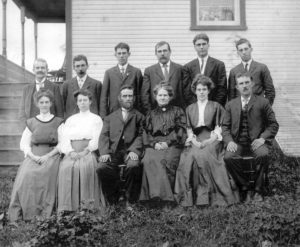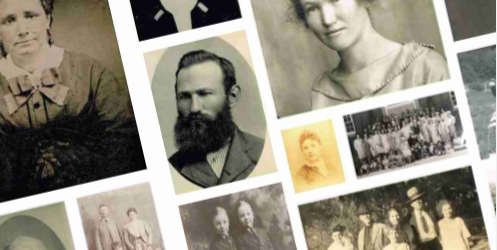Inside the Guide: Pre-1850 Census Research Tips
Census records can provide an abundance of information about your ancestors. Some of this information could include where they lived, who lived  with them, how old they were, where they were born, etc. The United States federal census records began in 1790, but the 1790-1840 censuses listed only the head of household, not every individual in the household. The other members of the family were represented by numbers or tally marks in corresponding gender and age categories. When you find a pre-1850 census with a name that may potentially be your ancestor, just seeing a list of names and a bunch of numbers can be intimidating. However, you don’t need to be discouraged by the lack of information on these records: you can find your ancestors on these records, whether they were the head of household or not.
with them, how old they were, where they were born, etc. The United States federal census records began in 1790, but the 1790-1840 censuses listed only the head of household, not every individual in the household. The other members of the family were represented by numbers or tally marks in corresponding gender and age categories. When you find a pre-1850 census with a name that may potentially be your ancestor, just seeing a list of names and a bunch of numbers can be intimidating. However, you don’t need to be discouraged by the lack of information on these records: you can find your ancestors on these records, whether they were the head of household or not.
Here are a few tips to help guide you while conducting research on pre-1850 United States census records, using one of my ancestors as a case study.
For some background on the case study, my ancestor David McKee was born in 1796 and died in 1847. The only census records he would be found in would be pre-1850 census records. David married Mary Tweed McMillan in 1816, so he would likely be the head of household in 1820. David and Mary had 11 children, born from 1817 to 1835.
- Start with what you know. When conducting a search for your ancestor on pre-1850 census records, fill out as much information as you know about them in the search bars. That will help narrow the search parameters and limit the number of irrelevant results that come up.
- Know where your ancestors may have lived. While it is true that census records are often used to figure out where an ancestor lived, when conducting research with pre-1850 census records, you need to find out a general area where your ancestor might have lived during the time the census was conducted. Otherwise, it will be difficult to narrow down which name on the census is really theirs. Take a look at birth and marriage records or even compiled family histories (such as the information on FamilySearch Family Tree) that may provide additional evidence on where your ancestor could be found. While I was conducting a pre-1850 census survey for David McKee, I found several different men named David McKee, living all over the United States. I was able to narrow them down because I knew David was born and had been married in Pennsylvania. Additionally, according to family tradition, all 11 of his children had been born in Butler County. When I found a man named David McKee in Slippery Rock, Butler, Pennsylvania on the 1820 census, I had more reason to look into this entry than the other places because I had a general knowledge of where David and his family lived during that time.
- Correlate the information on the census with other records. If you find a potential entry for your ancestor on a pre-1850 census record, make sure the information and records you have already found support the information on the census record. Other records can help prove or disprove if this is the correct person. It might also be helpful to look at post-1850 censuses first and work backward, so you’ll have a general idea of how old the family members would be and who would be living in the household.
- Make sure you have evidence of the family structure. Simply finding a name on a census that is the same as your ancestor in a place they might have lived will not help you prove that is the correct person. You need to have a basic idea of how many individuals were in the family and when they were born to help support your findings. For example, I found a potential census record for David McKee on the 1820 census in Slippery Rock, Butler, Pennsylvania. I knew that by 1820, David and Mary had three sons, all under the age of ten. So, there would likely be five members of the household in 1820, including David and Mary. The entry I found on the 1820 census had five people in the household and thus far supported the family structure:
 The tally mark on the far right does not represent an additional person, that tally mark indicates the type of trade that David was engaged in. In this case, he was involved in agriculture.
The tally mark on the far right does not represent an additional person, that tally mark indicates the type of trade that David was engaged in. In this case, he was involved in agriculture. - Figure out who each number/tally mark represents. Once you have a general idea of what the family “should” look like in the census record, start figuring out who each number and tally mark represents, taking a look at the age and gender categories. An example of what the age and gender categories might look like can be seen below. It is important to note that the age and gender categories may not be the same on every pre-1850 census record. The 1820 record with my ancestor on it, started with males under the age of 10:

Taking into consideration the structure of the McKee family and the age categories on the census record, I was able to figure out who each number represented. The three males that were in the “males under age 10” category were David Thomas McKee (born 1817), Daniel McKee (born 1818), and James McKee (born 1820). The male that was in the males age 16 through 25 category was David McKee (born 1796), and the female that was in the females age 16 through 25 category was Mary Tweed McMullian (born 1795).
If you are able to match up the majority of people in the census record, and there is someone who is unaccounted for, it does not necessarily mean that this is the incorrect family. It simply means there could be an additional person living in the household that will require additional research to identify. It might also be useful to create a spreadsheet for determining who the tally marks are on the census record so you can keep track of them.
Another thing to keep in mind: make sure you indicate how a particular person is represented on the census record when his or her name is not specifically listed. For example, when you attach the record to FamilySearch Family Tree, it would be helpful to say something along the lines of “James McKee is represented on the census record by one of the three individuals found in the ‘males under 10’ category.”
In conclusion, pre-1850 census records can be tricky, but don’t be discouraged about doing research for your ancestors who lived during this time period. With a little extra detective work, you can account for every person in the household of your ancestor, even if each one is only represented by a single tally mark.
For additional information and resources, visit the Family History Guide, United States, Part C, Goal C2, Choice G: Explore census from 1840-1790.






Rachel, this is really a great post. So many people struggle with the tick marks on the first census records. Thank you for the tips and tricks for deciphering them.